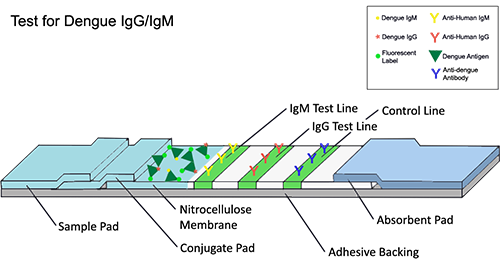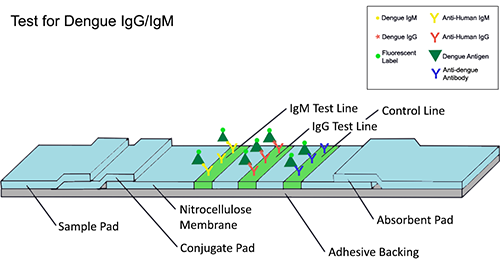Dengue LFA
Developing a fluorescence lateral flow assay (LFA) for detecting dengue, a febrile illness

Lateral flow assays (LFA) are known for their ease of use, compact form factor, portability, low cost, and quick time to results, with the most well known LFA being the at-home pregnancy test. This technology has a wide variety of possible applications, with one being disease detection in resource-limited settings.
I worked on the development of a lateral flow assay for the detection of dengue, a prevalent febrile illness. The process for the LFA is shown below.



Methodology
After initial attempts at creating an assay using latex beads as the detection label, I determined through experimentation and a thorough literature review that the limit of detection for the beads was too high for the intended application. Upon further review, we decided to develop a strip using fluorescent particles, which offer a wider dynamic range in analyte concentration and signal level, as the detection label. However, this also meant that more specialized hardware and software would be needed to read the signal produced, which led to the design of the Tidbit.The test strip itself, which is a nitrocellulose membrane, has its own background fluorescence. For this reason, we first verified that a fluorescent LFA was a plausible idea by determining what concentration of fluorescent label was necessary to be easily detected against the membrane. After establishing that a clear boundary could be seen between excessively diluted fluorescent particles and the nitrocellulose membrane, I began assembling the strip components.
First, it was necessary to conjugate recombinant polyvalent dengue antigen to a fluorescent label, which involved binding fluorophores to primary amines on lysines present throughout the antigen. After completing the conjugation, the protein concentration could be determined through absorbance measurements in conjunction with the Beer-Lambert equation. This allowed us to determine the degree of labeling of the antigen.
The anti-dengue was supplied as whole antiserum and needed to be purified. Because Protein A has the highest binding capacity for subclasses of IgG from rabbits, Protein A purification was chosen for the anti-dengue.